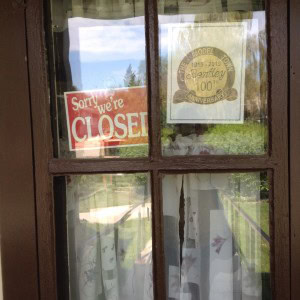“Sorry, We’re Closed,” read the sign on the door of the small Albertan museum I had traveled hours to get to and planned to conduct research at last Monday. I sighed, “What now?” I thought to myself as I climbed back into my car …
I think it is safe to say that there is only one thing one can plan on during a research trip: close to nothing will go as planned. Research trips, I have found, are closer to a comedy of errors than a scientific process. Archives and museums are closed or short-staffed through no fault of their own, finding aids are out of date, the items in a collection do not match up to the promise of their online descriptions, the perfect document is off limits, etc. This summer, thwarted and delayed by immigration issues, rather than make a grand tour of Alberta and Idaho, I had to settle for a week in the Edmonton, Alberta, area.
The stress of these unplanned obstacles is tenfold when one is working on a transnational dissertation or other project that is transnational in theme. My dissertation is a comparative history of provincial and state parks in Canada and the United States, focusing on the park systems of Alberta, Idaho, Ontario, and Pennsylvania. Unlike my peers working on more geographically compact projects, I am unable to stay an extended amount of time at one archive. Bouncing back and forth across the border and the continent, I have been to a dozen archives and research locations so far and plan to visit more.
This reality has a substantial effect on the way in which I can realistically conduct research and write my dissertation. I can often spend only a maximum of a week to 10 days, but often far less time, at one archive. Unable to spend time looking at the documents thoroughly, I am forced to take as many photographs as humanly possible. And, not knowing how each case study will intermingle with the rest, it is often difficult to truly get into the dissertation-writing process. Every historian faces this obstacle, but the realities of a multi-region or multi-nation project can exacerbate the issue.
Yet an expansive topic, particularly one based on parks, has its benefits, forcing me to look inside and outside of the traditional archive. On prior research trips I’ve talked to the cows at Bronte Creek Provincial Park, gazed down at a beaver pond at Algonalgquin Provincial Park, and gotten lost in newspaper clippings at the Idaho State Archive in Boise. And, despite the initial glitch, my most recent trip to Alberta led to fruitful experiences both in the field and in the stacks. I had one of the most, if not the most, successful, research trips of my dissertation journey thus far. Not only did I get to visit several parks, including my case study, Aspen Beach, in person, but I also struck gold in the Provincial Archives of Alberta in Edmonton.
Two of my major finds revolve around recreational expectations and public opinion. In the 1930s, the water level of Gull Lake—the lake on which Aspen Beach Provincial Park is located—began to recede quickly and unexpectedly. I found correspondence between park employees, government officials, and local cottage-owners from the 1930s–60s outlining proposals to artificially increase the lake’s water level and even a period of time when the Albertan government gave the park back to the cottage community, Aspen Beach, as the park was deemed recreationally “useless” to the province due to the water recession. These letters will prove invaluable to demonstrating the way in which Alberta placed recreation ahead of preservation in the early days of its park system. I also found 1974 survey results, which portray Calgary’s attitude toward the development of Fish Creek Provincial Park. Some of the entertaining results of this archival find are highlighted in my post, “‘Do Not Want Hippies, Motorcycles or Catholics’: The Public’s Vision for Fish Creek PP, 1974”.
… I get in the car and head to Aspen Beach Provincial Park. I still find the openness of the Canadian prairie landscape unsettling, but beautiful. I look across the expanse of the lake bathed in sunshine, unencumbered by the obstacles of trees or mountains. The scene unfolds in front of me; the juxtaposition of the lake’s natural beauty with the horde of sunbathers and sandcastle makers bringing the historical realities of the documents I found in the archive to life.I close my eyes and soak in the sunshine. This is a good gig.
This post first appeared on AHA Today.
Jessica DeWitt is a PhD candidate in history at the University of Saskatchewan. She is a lab assistant in the Historical GIS Lab at the university. She is the social media editor for Network in Canadian History and Environment (NiCHE) and editor of Folklore magazine for the Saskatchewan History and Folklore Society. Her dissertation is a comparative history of the development of provincial and state parks in Canada and the United States. She tweets @JessicaMDeWitt
This work is licensed under a Creative Commons Attribution-NonCommercial-NoDerivatives 4.0 International License. Attribution must provide author name, article title, Perspectives on History, date of publication, and a link to this page. This license applies only to the article, not to text or images used here by permission.






